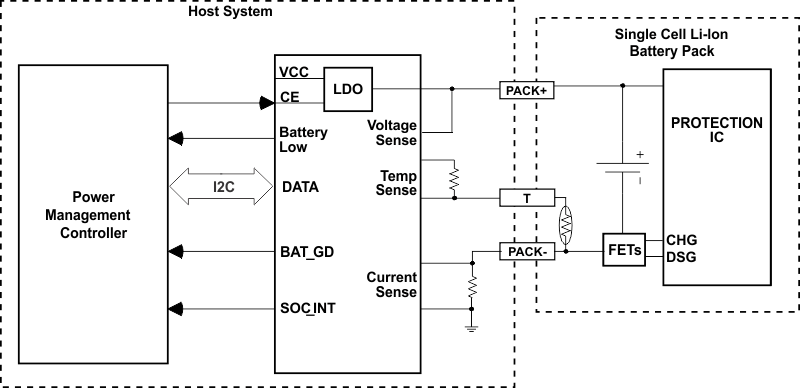JAJSNB9C November 2012 – November 2021
PRODUCTION DATA
- 1 特長
- 2 アプリケーション
- 3 概要
- 4 Revision History
- 5 Device Comparison Table
- 6 Pin Configuration and Functions
-
7 Specifications
- 7.1 Absolute Maximum Ratings
- 7.2 ESD Ratings
- 7.3 Recommended Operating Conditions
- 7.4 Thermal Information
- 7.5 Electrical Characteristics: Supply Current
- 7.6 Digital Input and Output DC Characteristics
- 7.7 Power-on Reset
- 7.8 2.5-V LDO Regulator
- 7.9 Internal Clock Oscillators
- 7.10 ADC (Temperature and Cell Measurement) Characteristics
- 7.11 Integrating ADC (Coulomb Counter) Characteristics
- 7.12 Data Flash Memory Characteristics
- 7.13 I2C-Compatible Interface Communication Timing Requirements
- 7.14 Typical Characteristics
- 8 Detailed Description
- 9 Application and Implementation
- 10Power Supply Recommendations
- 11Layout
- 12Device and Documentation Support
- 13Mechanical, Packaging, and Orderable Information
3 概要
テキサス・インスツルメンツ BQ27520-G4 システム側リチウムイオン・バッテリ残量計は、シングルセル・リチウムイオン・バッテリ・パックの残量計測を行うマイクロコントローラ・ペリフェラルで、最小限のシステム・マイクロコントローラ・ファームウェア開発で動作します。このバッテリ残量計はシステムのメイン・ボードに配置され、取り外し不可の組込みバッテリまたは着脱可能なバッテリ・パックを管理します。
特許取得の Impedance Track™ アルゴリズムを残量計測に使用し、残りのバッテリ容量 (mAh)、充電状態 (%)、残り動作時間 (最小値)、バッテリ電圧 (mV)、温度 (℃)、健全性状態 (%) などの情報を取得します。
バッテリ残量の計測に必要なのは、着脱可能なバッテリ・パックまたは内蔵バッテリ回路への PACK+ (P+)、PACK– (P–)、およびオプションのサーミスタ (T) 接続のみです。公称寸法 2610 × 1956µm、リード・ピッチ 0.5mm の 15 ボール NanoFree™ (DSBGA) パッケージを使用します。
このため、スペースに制約のあるアプリケーションに最適です。
製品情報
| 部品番号 | パッケージ(1) | 本体サイズ (公称) |
|---|---|---|
| BQ27520-G4 | DSBGA (15) | 2.610mm × 1.956mm |
(1) 利用可能なすべてのパッケージについては、このデータシートの末尾にある注文情報を参照してください。
 代表的なアプリケーションの図
代表的なアプリケーションの図